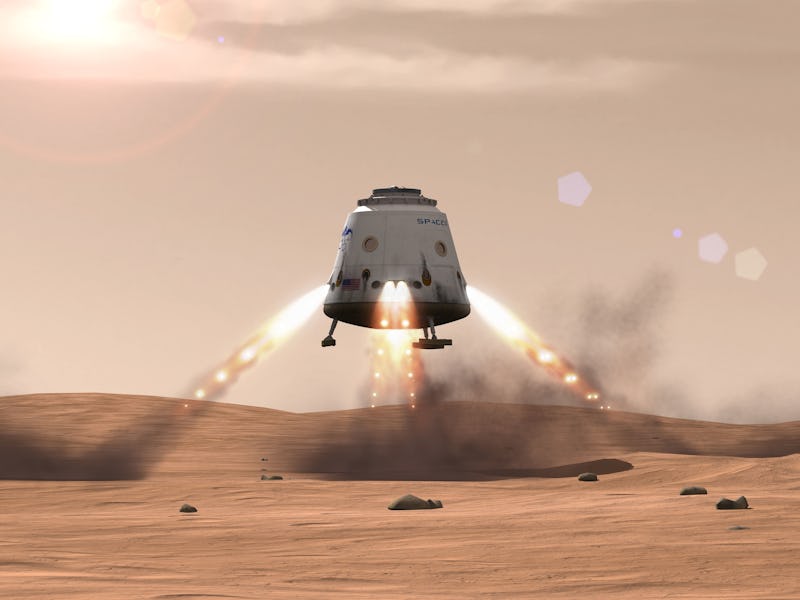What's Up With SpaceX's Mars-Bound Red Dragon?
The souped-up variant of the Dragon 2 will hitch a ride on the massive Falcon Heavy rocket in 2018.

SpaceX announced its plans today to send its uncrewed Red Dragon spacecraft to Mars as early as 2018. The company first teased the vessel in 2015 with dreamy artist renerings of a Dragon craft landing on the surface of Mars. And Elon Musk’s company made it clear with today’s news that the spacecraft is beyond the concept stage.
The Red Dragon spacecraft is a variant of SpaceX’s Dragon 2, which founder Elon Musk described as a crew-capable “science delivery platform” in 2015. Dragon 2 is itself a variant of the original cargo Dragon spacecraft, which has been used in supply runs to the International Space Station.
The Red Dragon isn’t meant to carry passengers beyond the Earth-moon region, at least not in this incarnation. As Musk notes in a tweet, the ship’s interior is roughly the size of an SUV. “Wouldn’t be fun for longer journeys,” he quipped. The 2018 mission will be, as expected, uncrewed.
Despite its small size compared to other spacecraft, the ship is hardy. In an interview in 2015, Musk said, “Dragon 2 is capable of transporting scientific payloads to anywhere in the solar system, with a liquid or solid surface, with or without an atmosphere.”
What Will Launch the Red Dragon to Mars?
SpaceX plans to launch the Red Dragon on the huge Falcon Heavy rocket, which SpaceX claims will be “the world’s most powerful rocket.” It will take off from SpaceX’s Pad 39A at the Kennedy Space Center. Propelled by the rocket, the Red Dragon “can go pretty much anywhere,” Musk said in a press conference on Wednesday. SpaceX president Gwynne Shotwell said last month that a Falcon 9 Heavy initial test launch would happen later this year.
How Will the Red Dragon Land on Mars?
Landing the Red Dragon, with a payload weighing up to four tons, will be no easy feat. Weighing in at 10 tons, the capsule is too heavy for parachutes and for the rocket-powered “sky crane” system used to drop the Curiosity rover onto the Red Planet’s surface. Instead, like its Dragon relatives, the Red Dragon will use an eight-engine SuperDraco propulsive landing system to touch down. Here’s it being tested in Texas:
Key for Mars landing: The Dragon 2’s SuperDraco propulsive landing system, which was recently tested at SpaceX's McGregor, Texas facility.
Here’s an artist’s rendering that imagines how the Red Dragon might touch down on the surface of the red planet as soon as the year 2018.
The Red Dragon craft is a variant on the Dragon 2, shown in the artist’s rendering above.
In addition to the SuperDracos, the Red Dragon variant has some unique features. It’s been reported that the Red Dragon will include a robotic arm for collecting Martian samples, extra fuel tanks, and an Earth Return Vehicle.
The latter will carry a capsule of samples back toward Earth by hitching a ride on the craft’s rocket-powered Mars Ascent Vehicle. The Dragon will also carry a suite of as-yet-unidentified scientific instruments, per SpaceX’s agreement with NASA.
There's the same amount of room inside as there is the typical SUV -- not good for a long ride.
The Red Dragon Mars mission, Musk confirmed in a follow-up tweet today, is the mission’s first test flight, but it certainly won’t be the last.
“Dragon 2 is designed to be able to land anywhere in the solar system,” he posted. “Red Dragon Mars mission is the first test flight.”